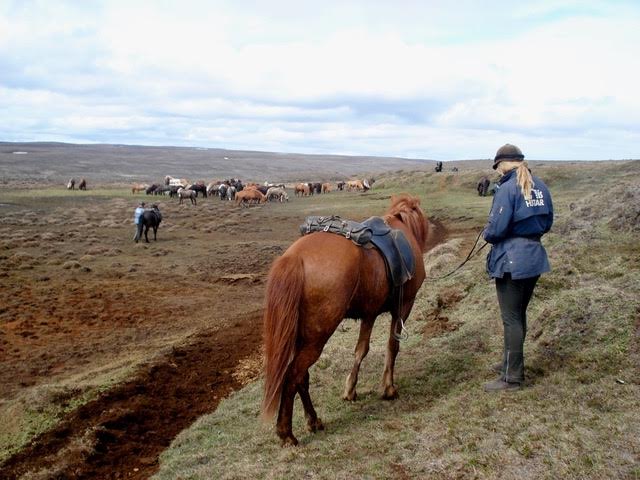Riding in the wilderness within a herd of horses is an experience unique to Iceland. This is why I chose to embark on the country’s most classic horse trek, Kjölu, with Ishestar, Iceland’s most venerable horse trek organization. The route took us more than 220 kilometers from South to North, through ancient lava fields and between volcanoes. The route was filled with historical, cultural, and sensorial significance, in the company of 11 riders and 77 free-running horses.
We moved with a herd due to the nature of Icelandic horses and the landscape surrounding them. Most horse treks for experienced riders include a mixture of three gaits: walk, trot, and canter. Icelandic horses have a different formula known as a tölt. Faster than a trot, the four-beat tölt is theoretically much smoother.
Tölting enables you to move quickly and comfortably over volcanic, rock-strewn roadless countryside, though it does tire the horses. Ishestar made sure to bring enough equines on the trek so we could change our mounts once or twice a day.
Our group of 11 riders, plus our guide Svandis, got along well. That was fortunate in light of our overnight lodgings, which were mountain cabins with communal sleeping arrangements. Each evening we lined up for showers, since daily tölting left our clothes covered with fine brown powder and thick dark mud. The meals at the cabins were surprisingly delicious. Asa, our cook, was also our co-host. Our herd of horses belonged to her and her husband Hjalti. She plied us with dishes like fish cakes and barbecued lamb from their farm.
The scenery the first few days consisted of slate or lava grey gravel, distant mountains hosting the Langjökull and Hofsjökull Glaciers, glassy lakes and icy streams. On day three, in the middle of the country, we slept in a rustic cabin at Hveravellir, a geothermal area in the highlands, where we indulged in a hot bath under the Midnight Sun, with cold beer served as we soaked.
The latter part of the trek was more colorful, with boggy mounds of dark earth tufted with lichen, grasses, low-lying shrubs, and occasional wildflowers. Always the play of light and dark in these empty spaces exerted its own fascination. Svandis told us stories and sang songs about Icelandic trolls and bandits and folk heroes.
We crossed three rivers on our fourth day. I rode a horse named Kvistor that afternoon and he loved the water. He was as excited as a schoolboy as we tölted along the riverbank of the first river. As soon as we headed in, he became Mr. Grand Prix Gelding, zooming past one horse after another.
You need a high tolerance for water, dirt, and long hours in the saddle, up to seven a day, most of them over bone-jolting terrain regardless of the smoothness of the tölt of an individual horse. You also need to be prepared for unpredictable weather and the uncertainties of horse riding in general.
If you are an experienced rider and curious about Iceland, there is no better way to see this country. Spectacular scenery viewed from feisty little horses and, if you are lucky, a fantastic guide like Svandis to tell exciting stories about the culture make for an unforgettable eight days.
About the Author:
Claudia’s articles have appeared in the International New York Times, The Economist Intelligence Unit, Newsweek, and dozens of publications worldwide, as well as books. She has fallen off horses on six continents, visited 100 countries, and trained dogs in three languages.
Do you have a great story, blog post, poem or other creative written content about Iceland that you want to share with our audience? You’re in luck! We’d love to showcase your work on IcelandNaturally.com. Click here to learn how you can get involved.


Comments
article Next
article